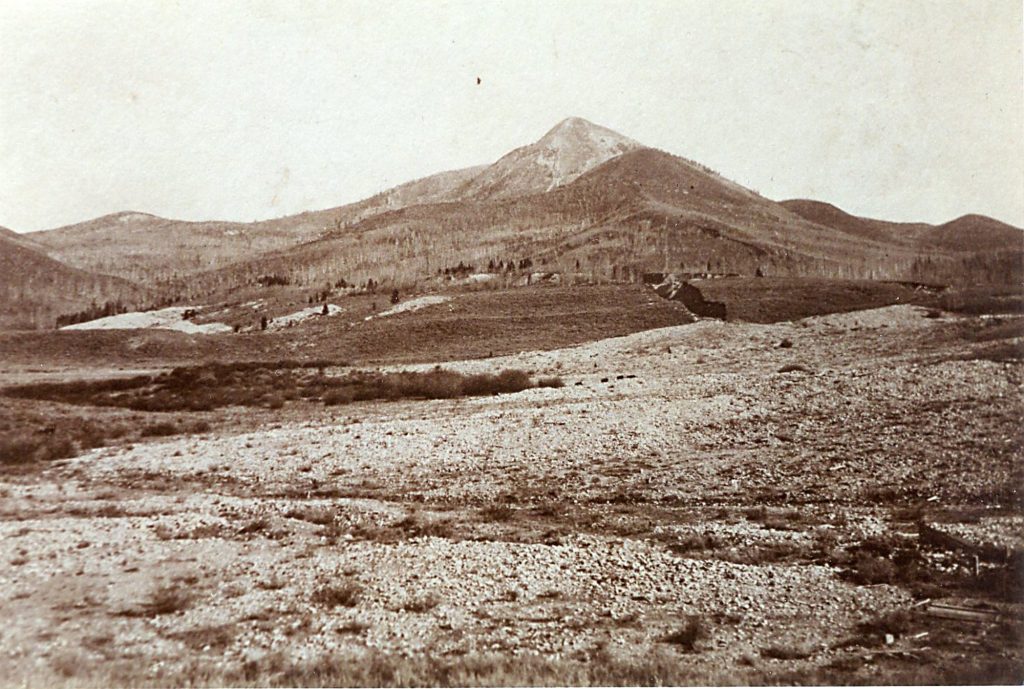Historian investigates confusion surrounding the name of one of Northwest Colorado’s most iconic peaks

Museum of Northewest Colorado/Courtesy photo
Paul Knowles has spent countless hours and days looking through newspaper articles online at Colorado Historic Newspapers Collection, hoping to bring some clarity to the confusion that surrounds the name Hahns Peak.
“It’s one of the things where there have always been some rumblings that perhaps that wasn’t the name,” said Knowles, who is the assistant director at the Museum of Northwest Colorado in Craig. “Unfortunately, nothing is usually cut and dry when you’re a historian; it is always a little bit muddy. With this one, there was enough legs that I feel comfortable with what I have found.”
Knowles said he has always had an interest in Hahns Peak, and he wanted to investigate the confusion surrounding the naming of the 10,774-foot peak located 34 miles north of Steamboat Springs.
He believes that prospector Joseph Henn’s thick German accent may have resulted in the confusion around the name and the variety of spellings that include Henne, Hand, Hantz and Hahn in the historical documents that have been passed down.
Knowles, who heard rumors about the name, dug deeper by visiting the Colorado Historic Newspapers Collection, looking into signatures on mining claims in the Hahns Peak area and finding references in documents where family members corrected the spelling for Henn’s name.

Support Local Journalism
Knowles pointed to a story that appeared in the Georgetown Courier on Aug. 31, 1895, which appeared nearly 30 years after Henn’s death. The story of survival and death includes a first-hand account from William Doyle, who was with Henn before he died of cold and starvation in the mountains of northwest Colorado in 1867.
“In the first place, that name is spelled wrong,” Doyle is quoted in the story. “Joe always spelled it Henn, and not Hahn, but I suppose that will always go down in history.”
Doyle’s story recounts how Henn came to the area in the early 1860s and brought George Way in 1865. The men left that winter, but returned late in the summer of 1866 with a collection of roughly 50 men.
The early prospectors set up camp in the shadows of Hahns Peak, and spent the rest of the summer and much of the fall searching for gold. By October, however, most of the prospectors had left the area for the winter, except for a small group of men that included Henn, Doyle and Way.
It was decided that Way would go to Empire to restock on provisions and then return. He left with the men’s gold and never came back, leaving Doyle and Henn to fend for themselves in the harsh mountain weather.
Henn and Doyle survived most of that winter by hunting and eating small game, but by April, the two men were desperate. They set out on snowshoes with hopes of reaching Empire, but the trip was difficult and they eventually decided to head to a place called Jones’ Ranch.
They knew it was located at the junction of Muddy Creek and the Grand River, but neither had been there or knew its exact location. The men reached the banks of the Grand River (changed to the Colorado River in 1921), where Henn collapsed and was unable to continue. Doyle sought to find the ranch with hopes of returning to help his friend, but he couldn’t find it, and returned to find that Henn had passed away.
“I wrapped him up in the cavalry coat and his blankets and then started out on my search for food and shelter,” Doyle wrote. “Expecting to meet the same fate as Henn, I wrote a farewell in my notebook and gave the address of my relatives.”
Doyle was eventually rescued on May 3, 1867, and finally made it back to Empire on June 2.
“I was blind for six months and my right eye has never recovered from the hardships experienced on the trip of almost thirty years ago,” Doyle said in the story. “I never returned to the diggings, for I heard that the claims had all been gobbled up. Since that time, I have virtually spent all my time in Clear Creek country, near Idaho Springs.”
Doyle is credited for naming the peak after climbing to the top and burying a note that said “Henn’s Peak” in a sealed can while his friend was asleep in the camp. After Henn’s death, Doyle never returned to the camp, and lived out his life in a soldiers home in Montrose. He told this story to the Georgetown Courier (Aug. 31, 1895) and Rocky Mountain News (Sept. 9, 1877), where he corrected the name.
Looking into the naming of Hahns Peak was a project of passion for Knowles, who said he has been fascinated by gold mining since he was a child. With his position at Museum of Northwest Colorado, he is able to now dig further into the topic.
“I’ve always been fascinated with gold prospecting,” Knowles said. “I had two mining claims, gold mining claims at Hahns Peak for a little while, so I’ve always just had this personal connection to that area, and I really wanted to get the history down.”
He said Charles Harmon Leckenby, the longtime editor and publisher of the Steamboat Pilot, was compelled to record the facts and stories of the first 75 years of history in Steamboat Springs with his book “Tread of Pioneers,” which has become a historical resource.
“He did an excellent job and he tells the story of that area, the one that’s typically told,” Knowles said. “Those are always good starting places, and him and (John) Burroughs being the same thing, they typically get you onto a story, but then you got to start digging deeper to kind of start correcting it.”
Many of the landmarks in the area carry the names of the first prospectors that came to the valley during a mining boom around Hahns Peak — including Farwell Mountain, named after J.V. Farwell, who invested large amounts of money in the camps and hydraulic mining operations. Today, many of the structures that defined that area in that time have vanished, but mining legacy continues to live on in the names (right or wrong) and stories of the men who came looking for gold.
“I now feel 99.9% that his name was Henn,” Knowles said after recently stumbling onto another historic article. “That’s up from 97% when we talked before.”
This story is from SteamboatPilot.com









